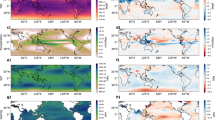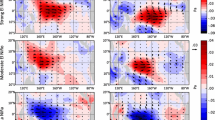Abstract
The periodicity of ENSO in nature varies. Here we examine how changes in the frequency of ENSO impacts remote teleconnections in the North Pacific. The numerical experiments presented here are designed to simulate perfectly periodic ENSO in the tropical Pacific, and to enable the air–sea interaction in other regions (i.e., the North Pacific) via a simple mixed layer ocean model. The temporal evolution and spatial structure of the North Pacific SST teleconnection patterns are relatively insensitive to the frequency of ENSO, but the amplitude of the variability is sensitive. Specifically, the 2-year period ENSO experiment (P2) shows weak event-by-event consistency in the ENSO response mature pattern. This is because there is not enough time to damp the previously forced ENSO teleconnections (i.e., 1 year earlier). The 4-year period ENSO experiment (P4) has 1 year damping time before a successive ENSO event matures, so the structure of the response pattern is stably repeated. However, the event-by-event variance of anomaly magnitude, specifically responding to El Niño, is still larger than that in the 6-year ENSO experiment (P6), which has 2-year damping time between consecutive ENSO events. In addition, we tested whether the variability due to tropical remote forcing is linearly independent of the extratropical local variability. Statistical tests indicate that tropical remote forcing can constructively or destructively interfere with local variability in the North Pacific. Lastly, there is a non-linear rectification of the ENSO events that can be detected in the climatology.


















Similar content being viewed by others
Notes
We also tested a domain of meridional mean, 35–55°N, but there are only minor differences from the domain from 40–50°N.
The climatologies in the P2, P4, and P6 experiments are different from each other, which is consistent with the argument that the details of ENSO forced patterns in each experiment are different. However, the differences among the P2, P4 and P6 experiments are not large as those between the ENSO experiment (e.g., P2, P4 or P6) and control run.
In the case of P2 experiment, for example, there are 30 samples to calculate the standard deviation due to 2 year period for 60 simulation years. In the same way, the P4 experiment has 15 samples, and the P6 experiment has 10 samples for the composite.
From the total 58 years (1948–2005), 18 ENSO composite years are excluded, so the length of Obs Control is 40 years. Excluded ENSO year is 12 months from Jun in previous year (year 0) to May in subsequent year (year 1), which is based on the NINO3.4 composite evolution shown in Fig. 15a.
References
An S-I, Wang B (2000) Interdecadal change of the structure of the ENSO mode and its impact on the ENSO frequency. J Clim 13:2044–2055
Collins WD, Rasch PJ, Boville BA, Hack JJ, McCaa JR, Williamson DL, Briegleb BP (2006) The formulation and atmospheric simulation of the community atmosphere model version 3 (CAM3). J Clim 19:2144–2161
Graham NE (1994) Decadal-scale climate variability in the tropical and North Pacific during the 1970s and 1980s: observations and model results. Clim Dyn 10:135–162
Hoerling MP, Kumar A, Zhong M (1997) El Niño, La Niña, and the nonlinearity of their teleconnections. J Clim 10:1769–1786
Hoerling MP, Kumar A, Xu T (2001) Robustness of the nonlinear climate response to ENSO’s extreme phases. J Clim 14:1277–1293
Jin D, Kirtman BP (2009) The extratropical sensitivity to the meridional extent of tropical ENSO forcing. Climate Dyn. doi: 10.1007/s00382-009-0600-1
Kalnay E et al (1996) The NCEP/NCAR 40-year reanalysis project. Bull Am Meteor Soc 77:437–471
Kestin TS, Karoly DJ, Yano J-I (1998) Time–frequency variability of ENSO and stochatic simulations. J Clim 11:2258–2272
Kiehl JT, Hack JJ, Bonan GB, Boville BB, Williamson DL, Rasch PJ (1998) The National Center for Atmospheric Research Community Climate Model: CCM3. J Clim 11:1131–1149
Kim K-Y, O’Brien JJ, Barcilon AI (2003) The principal physical modes of variability over the tropical Pacific. Earth Interact 7(3):1–32
Kirtman BP, Shukla J (2002) Interactive coupled ensemble: a new coupling strategy for CGCMs. Geophys Res Lett 29:1029–1032
Liu Z, Alexander M (2007) Atmospheric bridge, oceanic tunnel, and global climatic teleconnections. Rev Geophys 45:RG2005. doi:10.1029/2005RG000172. http://www.agu.org/pubs/crossref/2007/2005RG000172.shtml
Rayner NA, Parker DE, Frich P, Horton EB, Folland CK, Alexander LV (2000) SST and sea-ice fields for ERA40 proceedings of the second WCRP international conference on reanalyses. World Climate Research Program, Wokefield Park, Reading, United Kingdom, pp 18–21
Toniazzo T (2006) Properties of El Niño-Southern oscillation in different equilibrium climates with HadCM3. J Clim 19:4854–4876
Trenberth KE, Hurrell JW (1994) Decadal atmosphere-ocean variations in the Pacific. Clim Dyn 9:303–319
Trenberth KE, Branstator GW, Karoly D, Kumar A, Lau N-C, Ropelewski C (1998) Progress during TOGA in understanding and modeling global teleconnections associated with tropical sea surface temperatures. J Geophys Res 103:14291–14323
Yeh S-W, Kirtman BP (2004) The impact of internal atmospheric variability on the North Pacific SST variability. Clim Dyn 22:721–732
Zelle H, Oldenborgh GJV, Burgers G, Dijkstra H (2005) El Niño and greenhouse warming: results from ensemble simulations with the NCAR CCSM. J Clim 18:4669–4683
Acknowledgment
This manuscript is a part of George Mason University PhD dissertation of DJ. DJ would like to thank dissertation committee members, Professor Tim DelSole, Edwin Schneider, and David Straus for comments and suggestions improving the manuscript. We also thank two anonymous reviewers for improving the first draft of this paper. BPK acknowledges support from NOAA grants NA17RJ1226 and NSF grants OCI0749165 and ATM0754341.
Author information
Authors and Affiliations
Corresponding author
Appendix
Appendix
1.1 Statistical significance of spatial correlation
Here we present an additional calculation addressing the statistical significance of correlation coefficients shown in Table 3. In Table 3, the spatial correlation coefficient of the seasonal ENSO composite is calculated for entire 60-year record. The ENSO composite pattern is made from the average of 30 El Niño and La Niña events in the P2 experiment, 15 ENSO events in the P4 experiment, and 10 ENSO events in the P6 experiment. In order to support the results shown in Table 3 and exclude any sampling issues, we calculated the correlation coefficients based on a sub sampled, 36-year periods. The 36 year ENSO composite means 18 ENSO events in the P2 experiment, 9 ENSO events in the P4 experiment, and 6 ENSO events in the P6 experiment. We chose three different sub-periods for the calculation. If we assume that the entire 60 years period is from year 1 to year 60, the first sub-period (SP1) is from year 1 to year 36, the second sub-period (SP2) is from year 13 to year 48, and the third sub-period (SP3) is from year 25 to year 60. Table 5 displays the correlation results for the sub-periods. Comparing Table 3 with Table 5, the general trend is similar each other. In the El Niño composite, the spatial correlation between the P2 and P4 experiment is typically the highest, specifically from boreal winter to summer. In the La Niña composite, the correlation between the P4 and P6 experiment is also typically higher than the other columns. However, the details are not always similar between Tables 3 and 5. For example, Table 5 shows that the correlation in SP3 is different from those in SP1 or SP2 (e.g. P2 vs. P4 in boreal winter in the El Niño composite, P4 vs. P6 in boreal spring and summer in the La Niña composite). In summary, sub-sampled calculation of spatial correlation is generally consistent with entire period correlation although there are a few exceptions. Hence, this result strengthens the significance of Table 3.
Rights and permissions
About this article
Cite this article
Jin, D., Kirtman, B.P. The impact of ENSO periodicity on North Pacific SST variability. Clim Dyn 34, 1015–1039 (2010). https://doi.org/10.1007/s00382-009-0619-3
Received:
Accepted:
Published:
Issue Date:
DOI: https://doi.org/10.1007/s00382-009-0619-3




